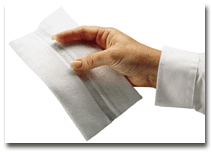Eastar Bio copolyester was introduced in late 1997 by Eastman Chemical Co., Kingsport, Tenn. Its unique chemistry makes it fully biodegradable in accordance with ASTM and German Institute for Standardization (DIN) standards. Under normal composting conditions, it breaks down into carbon dioxide, water and biomass after six months.
Economically competitive with other specialty polymers, it also is durable, strong,
liquid-impermeable and easily processed using conventional polyethylene extrusion machinery.
Promising applications include waste bags, disposable cups and plates, agricultural film, packaging, and a host of textile applications — agricultural products, medical textiles, diapers, feminine hygiene products, disposable washcloths and more. Textile products and concepts are currently in the development stages, with an emphasis on spunbond and composite nonwoven products. Eastman also plans to develop meltblown products.

Spunbond applications for Eastar Bio include disposable washcloths, hygiene products and
medical textiles.
Interesting Possibilities
“We have produced some very interesting spunbonds using some of the latest technology,” said Bill Haile, development associate, polyester polymers for fibers. “Eastar Bio makes a soft, quiet fabric that has some elastic properties. ” Medical fabrics can be sterilized by gamma radiation and other means, he added.
Agricultural and horticultural spunbonds include seed beds, erosion- and weed-control covers, and nutrient-delivery systems. Using these products, Haile said, “farmers can set their fields three weeks earlier.
After harvesting, these materials can be plowed under and provide additional soil nutrients. In some cases, this practice may permit a second growing season.” These possibilities have generated
particular interest in Europe, he added.
Eastar Bio also is of interest as a binder with natural, cellulosic and polylactide (PLA) fibers for disposable products.
“Until now, there has been no good biodegradable binder for natural fibers,” Haile said. “The resin has a melting point of 108°C (for fibers, it is 5°C to 10°C higher), so it sticks well to other substances and produces strong bonds with cotton, rayon, flax, kenaf, bagasse and fluff pulp without yellowing the fibers.”
As for PLA, he said, “there’s not much that bonds well to PLA, but this does.” In addition, because it breaks down only in a composting environment, it can be bonded with polyester, glass and other man-made fibers for durable applications.
Haile said the resin’s elasticity “is a key benefit for binder fibers, especially where high recovery of the nonwoven or batting is desired.”
Besides spunbond and binder applications, Haile noted a heavier-weight, card-bonded flax blend to form molded sheets for construction and automotive uses.
For more information about Eastar Bio, contact Robin McMurray (800) EASTMAN.
May 2002




